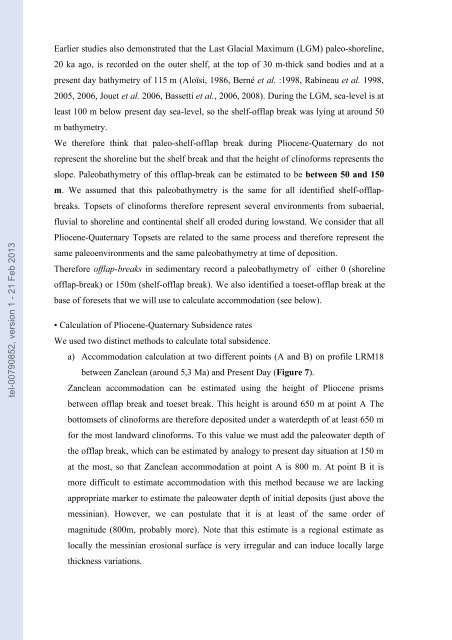Quantification des flux sédimentaires et de la subsidence du bassin ...
Quantification des flux sédimentaires et de la subsidence du bassin ...
Quantification des flux sédimentaires et de la subsidence du bassin ...
Create successful ePaper yourself
Turn your PDF publications into a flip-book with our unique Google optimized e-Paper software.
tel-00790852, version 1 - 21 Feb 2013<br />
Earlier studies also <strong>de</strong>monstrated that the Last G<strong>la</strong>cial Maximum (LGM) paleo-shoreline,<br />
20 ka ago, is recor<strong>de</strong>d on the outer shelf, at the top of 30 m-thick sand bodies and at a<br />
present day bathym<strong>et</strong>ry of 115 m (Aloïsi, 1986, Berné <strong>et</strong> al. :1998, Rabineau <strong>et</strong> al. 1998,<br />
2005, 2006, Jou<strong>et</strong> <strong>et</strong> al. 2006, Bass<strong>et</strong>ti <strong>et</strong> al., 2006, 2008). During the LGM, sea-level is at<br />
least 100 m below present day sea-level, so the shelf-off<strong>la</strong>p break was lying at around 50<br />
m bathym<strong>et</strong>ry.<br />
We therefore think that paleo-shelf-off<strong>la</strong>p break <strong>du</strong>ring Pliocene-Quaternary do not<br />
represent the shoreline but the shelf break and that the height of clinoforms represents the<br />
slope. Paleobathym<strong>et</strong>ry of this off<strong>la</strong>p-break can be estimated to be b<strong>et</strong>ween 50 and 150<br />
m. We assumed that this paleobathym<strong>et</strong>ry is the same for all i<strong>de</strong>ntified shelf-off<strong>la</strong>p-<br />
breaks. Tops<strong>et</strong>s of clinoforms therefore represent several environments from subaerial,<br />
fluvial to shoreline and continental shelf all ero<strong>de</strong>d <strong>du</strong>ring lowstand. We consi<strong>de</strong>r that all<br />
Pliocene-Quaternary Tops<strong>et</strong>s are re<strong>la</strong>ted to the same process and therefore represent the<br />
same paleoenvironments and the same paleobathym<strong>et</strong>ry at time of <strong>de</strong>position.<br />
Therefore off<strong>la</strong>p-breaks in sedimentary record a paleobathym<strong>et</strong>ry of either 0 (shoreline<br />
off<strong>la</strong>p-break) or 150m (shelf-off<strong>la</strong>p break). We also i<strong>de</strong>ntified a toes<strong>et</strong>-off<strong>la</strong>p break at the<br />
base of fores<strong>et</strong>s that we will use to calcu<strong>la</strong>te accommodation (see below).<br />
• Calcu<strong>la</strong>tion of Pliocene-Quaternary Subsi<strong>de</strong>nce rates<br />
We used two distinct m<strong>et</strong>hods to calcu<strong>la</strong>te total subsi<strong>de</strong>nce.<br />
a) Accommodation calcu<strong>la</strong>tion at two different points (A and B) on profile LRM18<br />
b<strong>et</strong>ween Zanclean (around 5,3 Ma) and Present Day (Figure 7).<br />
Zanclean accommodation can be estimated using the height of Pliocene prisms<br />
b<strong>et</strong>ween off<strong>la</strong>p break and toes<strong>et</strong> break. This height is around 650 m at point A The<br />
bottoms<strong>et</strong>s of clinoforms are therefore <strong>de</strong>posited un<strong>de</strong>r a water<strong>de</strong>pth of at least 650 m<br />
for the most <strong>la</strong>ndward clinoforms. To this value we must add the paleowater <strong>de</strong>pth of<br />
the off<strong>la</strong>p break, which can be estimated by analogy to present day situation at 150 m<br />
at the most, so that Zanclean accommodation at point A is 800 m. At point B it is<br />
more difficult to estimate accommodation with this m<strong>et</strong>hod because we are <strong>la</strong>cking<br />
appropriate marker to estimate the paleowater <strong>de</strong>pth of initial <strong>de</strong>posits (just above the<br />
messinian). However, we can postu<strong>la</strong>te that it is at least of the same or<strong>de</strong>r of<br />
magnitu<strong>de</strong> (800m, probably more). Note that this estimate is a regional estimate as<br />
locally the messinian erosional surface is very irregu<strong>la</strong>r and can in<strong>du</strong>ce locally <strong>la</strong>rge<br />
thickness variations.

















